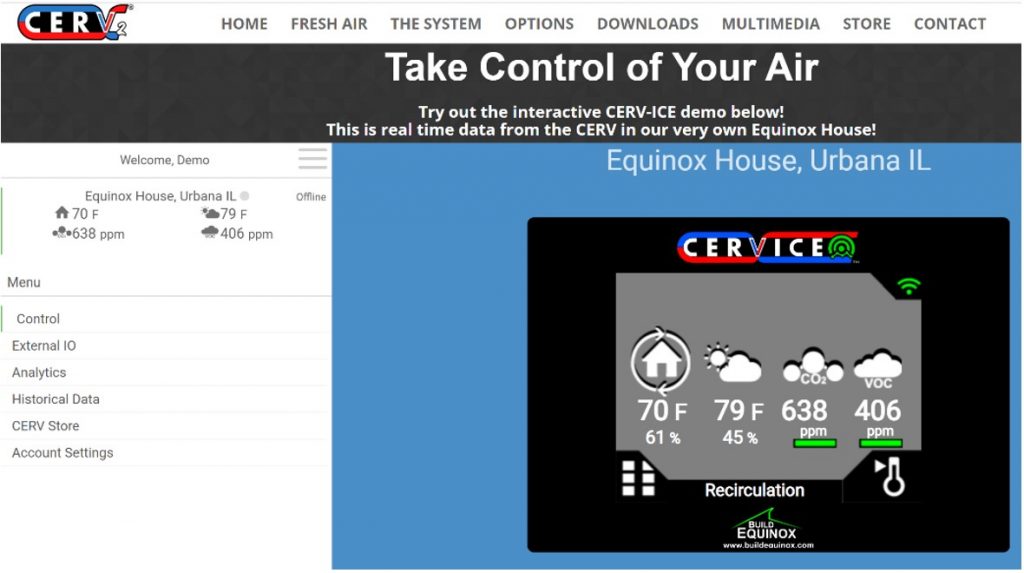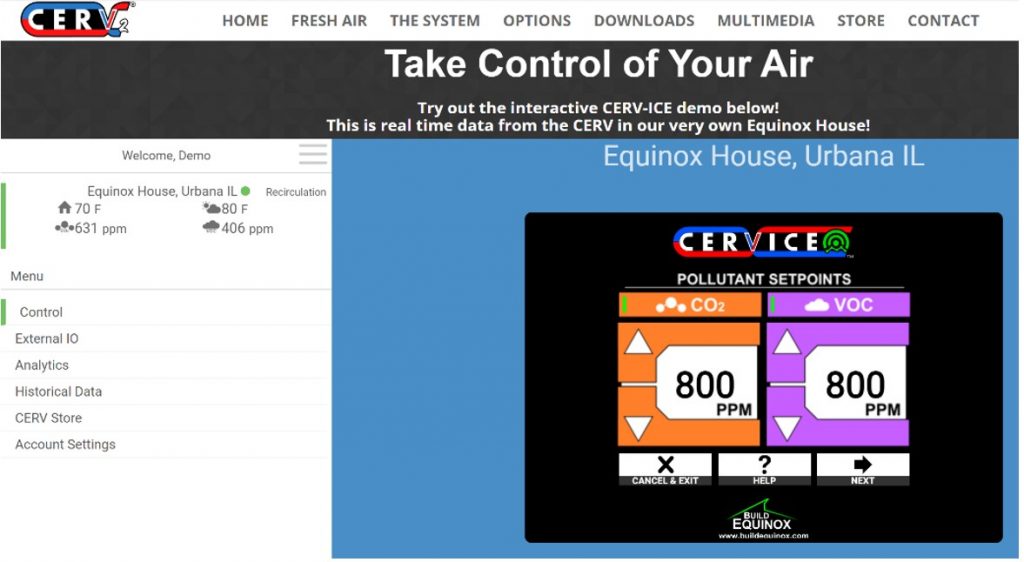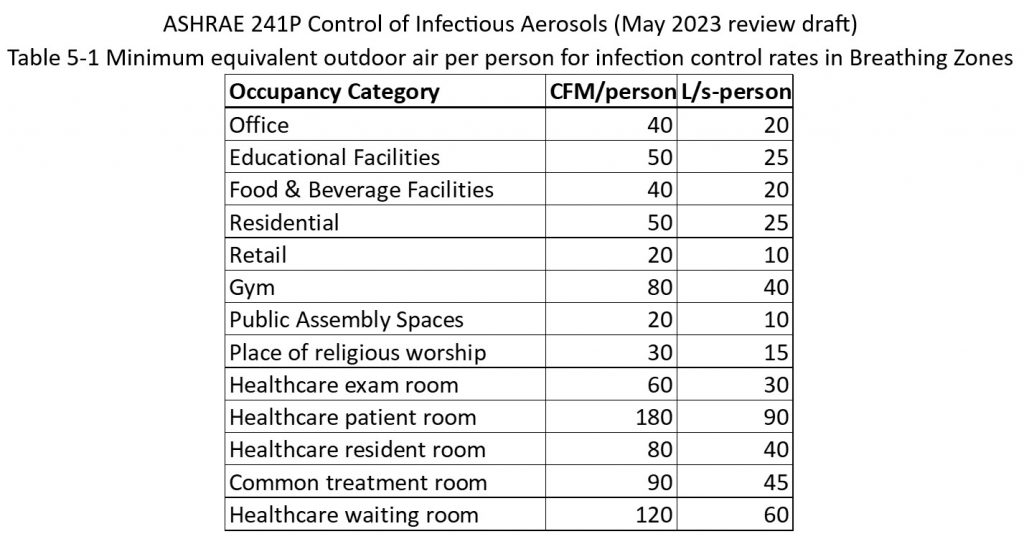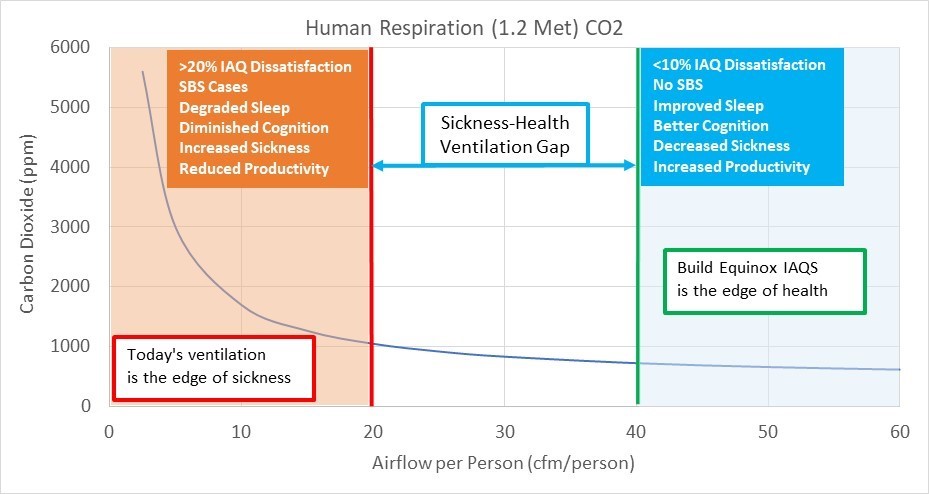
Harvard Professor Joseph Allen’s May 15, 2023 Washington Post opinion article entitled: “We might be on the verge of an indoor air quality revolution” says it well. We might be on the verge of a new era of building ventilation with ASHRAE’s release of a draft ventilation standard directed toward reducing airborne disease transmission in buildings.
Build Equinox has been a harsh critic of ASHRAE’s current odor-based ventilation standards for many years (“New IAQ Metrics to Avoid being Stupid, Sick and Tired”, NESEA 2017 presentation; “ASHRAE, You’re Making Us Sick!”, Build Equinox newsletter, Aug 2021), but not ASHRAE. We are proud members of ASHRAE, an engineering society dedicated to improving quality of life in the built environment. Our criticisms are directed toward the ventilation standards (62.1 for commercial buildings and 62.2 for residential buildings), not the society.
ASHRAE, as a result of a White House summit on airborne disease transmission, released a draft in May for the new standard: ASHRAE 241P, “Control of Infectious Aerosols”. The standard is expected to be in place by July 2023. Although the new standard is for reduction of airborne disease transmission when airborne pathogens are present, Professor Allen’s Washington Post opinion urges adoption of 241P as the basis for ventilation in all buildings. And we agree! A sea of airborne microbes always surrounds us in buildings, and adopting 241P as the basis for building ventilation is a cost-effective measure that easily pays for itself in improved health and productivity.
Draft standard 241P defines air quality from a human-centric basis, in alignment with Build Equinox’s healthy Indoor Air Quality Standard. Development of ASHRAE 241P is remarkable given many opposing viewpoints fighting to keep standards favorable to their interests while working to impose restrictive measures on their competitors. A narrow negotiation path balancing those interests is akin to as difficult a situation as one can imagine elsewhere in today’s complex, conflicted world. ASHRAE 241P has burst the dam, replacing the ineffective, iterative wordsmithing modifications of current 62.1 and 62.2 ventilation standards.
The good news for CERV, CERV2, and CERV-1000 owners is that you already meet ASHRAE’s healthy air standard! Set your CO2 and VOC concentration control levels to our recommended 800ppm (note; our CERV VOC units are a CO2 correlated scale), and you’re good to go. Figure 1 is a live screen shot of conditions in Equinox House, located in Urbana Illinois.

“Clicking” on the CO2 and VOC icons on the live Equinox House control screen shows current CO2 and VOC settings. These settings are rarely changed, and when they are, it is to lower their setpoint in order to increase fresh air flow due to someone catching the flu, a cold, or other airborne illness.

Figures 1 and 2 are from CERV-ICE (CERV-Intelligently Controlled Environment) dashboard, where CERV Community members can conveniently observe air quality and comfort conditions anytime. Note that online connectivity is built into all CERV units with no fees or subscriptions for CERV-ICE. With our OTA (over-the air) upgrading capability, new features and capabilities are broadcast to our CERV Community members as they become available (we thank many of you who have volunteered over the years to test new features before we release). Keep watching our newsletter for new feature announcements... we have some exciting new features coming soon!
Essence of ASHRAE 241P

Table 5-1 from ASHRAE 241P succinctly states the ventilation standard. Notice that unlike current minimum building standards (ASHRAE 62.1 for commercial and 62.2 for residential), there is no building size in the specification. Building size is irrelevant, as it should be. Occupancy and occupant activities are the important factors. Ventilation should not be used to make up for poor decisions in building design, materials selection, construction practices, and building operation.

Figure 3 is a plot from Build Equinox IAQ Standard showing the gap between ASHRAE’s current “minimum” ventilation standards and healthy air. Standard 241P leaps across the gulf separating today’s ventilation practices and ventilation needed for a healthy indoor environment. In most cases (eg, schools, restaurants, and residences), the new standard aligns with our definition of healthy air. Other situations, such as houses of worship, retail and public spaces are lower, presumably because of reduced exposure time to aerosolized microbes, however explanations for the choices are not presented in the draft (but may be included in explanatory appendices in the final standard). Gyms and frontline healthcare facilities have even more aggressive ventilation levels. Gyms and fitness centers require higher ventilation rates because higher metabolism increases respiration rates, and increased respiration increases aerosolized release of infectious microbes. Healthcare facilities, on the frontlines of every illness, understandably require enhanced fresh air and air filtration.
ASHRAE 241P essentially doubles today’s ventilation, and no longer discriminates against smaller homes. Yes, you’ve read that correctly. Current odor-based ASHRAE ventilation standards for residences discriminate against smaller homes with larger families. Since 2013, ASHRAE 62.2 has used the following formula for ventilation:
Ventilation (cubic feet per minute) = 0.03cfm/sqft x floor area (sqft) + 7.5cfm x (#bedrooms +1)
Comparing a 1000sqft home with 2 bedrooms with today’s average new home of 2700sqft with 4 bedrooms shows the air quality difference. The smaller home per ASHRAE 62.2 would have 52.5cfm of ventilation, or 17.5cfm/person if the assumed 3 occupants lived in the residence. The larger home would have 118.5cfm, or 23.7cfm/person, or 35% more fresh air.
But wait, there’s more! Larger homes have higher infiltration rates, augmenting ventilation levels. For example, reasonably good construction for both homes with 3ACH50 (3 air changes per hour at 50Pa infiltration tests) adds 54cfm on average to the larger home for a total of 172.5cfm, or a reasonably good 34.5cfm/person if 5 people lived in the larger home. The smaller home only adds 20cfm of infiltration air for a total of 74cfm, or 24.5cfm/person, for 40% air flow difference.
Another complication is actual occupancy of a household. Average household occupancy in North America is 2.5 occupants per residence. A larger home with today’s average household size would have 69cfm/person, well above 241P’s 40 to 50cfm/person, and a level where diminishing returns in reduced sick days and increased productivity are realized. A smaller home more affordable home may have 4 or more occupants, with only 13cfm/person based on 62.2 ventilation. As air flow per occupant decreases below 20cfm/person, as indicated in Figure 3, CO2 and every other category of indoor air pollutants (VOCs, particulates, and microbes) are rapidly increasing.
Cost-Benefits of 241P; Saving 165 Billion Dollar$ per Year!
Leaping across Figure 3’s gap separating today’s odor ventilation standards to a healthy ventilation standard effectively doubles fresh air ventilation. How much will it cost to improve ventilation systems to 241P. And how much will utility bills increase?
We can estimate the value of 241P in terms of airborne illness reduction (colds, influenza, RSV, Covid, etc). Data already exists that show doubling today’s ventilation to 241P levels will reduce sick days by 40%, or 1 sick day per person per year. 40% reduction in sick days is monumental. It is equivalent to sick day reduction associated with the influenza vaccine. Assuming the cost of a sick day to be $500 (cost of missed work, doctor’s visit, medication, etc), spread over the US population of 330,000,000 people is a cost savings of $165B/year! Rarely, if ever, has a building standard had this fiscal impact on the economy.
Reducing the spread of airborne disease is the smaller of potential gains with widespread implementation of 241P’s ventilation levels. Professor Allen and colleagues estimate productivity gains associated with increased cognition to be 10 times greater in value than the value of sick day reduction! While the magnitude of cognition-based productivity gains are currently under debate, even if the Harvard TH Chan School of Public Health for productivity are only 1/10th of their estimate, the value of a 1% productivity gain has a value equal to sick day savings for $330,000,000 in value.
Doubling today’s ventilation rate by 20cfm/person to 40cfm/person is a capital cost requirement of $400/person for a total cost of $130B, assuming $20/cfm for capitalization and installation of additional ventilation and energy recovery equipment. This is a 10:1 return on investment with $13B/year cost assuming 10 year equipment lifetime.
Professor Allen, et al investigated energy cost for enhanced ventilation across US climatic zones and found an annual utility cost increase of $50 per person per year in locations with challenging climates. Their model as based on the assumption of no energy recovery! Energy recovery is desirable and economical, and can be justified on the basis of energy savings. That is, human health does not need to be sacrificed to save energy. The bottom line is that $50/person per year saves $500/person per year in sick days and potentially increase productivity by more than $5000/person per year.
The opportunity to improve our health is an opportunity to improve our economy. Every dollar spent to improve ventilation is being spent on ourselves for increased manufacturing jobs and installation jobs in our communities. Coupled with today’s movement to decarbonize building energy usage by shifting to today’s high performance heat pumps powered by renewable energy adds another economic opportunity creating stable manufacturing jobs and community construction jobs. That's a good way to spend money!
We will revisit ASHRAE 241P as it moves through the review process. We will discuss how 241P aligns with Build Equinox IAQ Standard, and how it doesn’t. For now, let’s celebrate ASHRAE’s achievement to develop this revolutionary standard!























